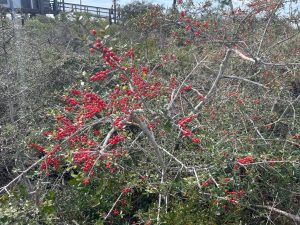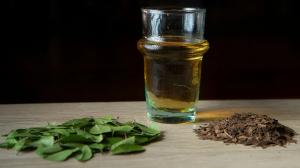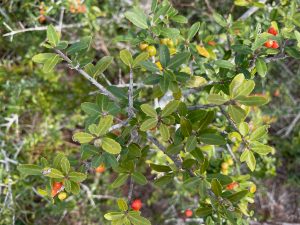
For most of the year, yaupon (pronounced “yo-pon”) holly is the nondescript evergreen backdrop to forested areas throughout the Panhandle. But in the fall, these plants are bursting with brilliant red berries. There are 9 holly species native to our area, all with evergreen, mostly oval shaped leaves. Of these, yaupon is among those with the smallest leaves. The species can be distinguished from the similarly sized myrtle-leaved holly by their leaf margins. While myrtle has smooth edges, yaupon has scalloped/serrated edges. Both species sport bright red berries, tasty only to birds and other wildlife.

The leaves, however, have historically been ingested by humans. I’ve tried homemade black yaupon tea, and it is quite tasty. Native Americans throughout the southeast made a “black drink” from yaupon holly as a natural stimulant and for use in ceremonies. It is one of just a handful of naturally caffeinated plants that grow in the wilds of North America, and Spanish explorers quickly took up the habit as well. Lore says that overconsumption can lead to stomach ailments, hence the Latin name Ilex vomitoria. By most accounts, however, you’d have to drink gallons of the stuff to actually get sick. Rumors that this unappetizing misnomer was deliberate still circulate, as during the late 1700’s, the American tea was starting to rival popularity of British teas. In addition to tea, Native Americans would use the plant medicinally and also convert the shrub’s typically straight branches into arrows.

Early American settlers drank yaupon tea frequently when tea was hard to obtain from overseas during the Revolution and Civil Wars. During the rationing periods of World War II, the American government encouraged the substitution of yaupon tea for coffee and other teas. While it never really took off in the 1940’s, Texas currently has a rapidly growing industry in harvesting the plant. Growers are selling it as tea and as flavoring for a wide variety of food and drink products. To maintain a steady supply of leaves, tea makers often clear landowners’ property of the yaupon shrubs, free of cost. This win-win solution provides an inexpensive harvest, reduces wildfire fuel, and allows native grasses and other open-canopy species to thrive.
For the most part, the plant is considered a nuisance in forested areas. It is one of those woody species that grows up quickly in areas that haven’t been maintained by fire on a regular basis. As a home landscape plant, it works well as an evergreen screen. While it can grow up to 20’ tall, it responds well to routine pruning. Most native hollies thrive in both wet and dry soils, so they are truly versatile. Being native, they are also salt-tolerant, drought-tolerant, wind resistant, and provide winter color and food for wildlife in their bright red berries.
 17
17
